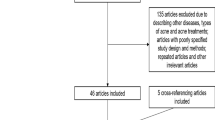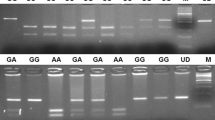Abstract
Acne is a multifactorial, chronic inflammatory disease of pilosebaceous unit in which cytokines have been implicated in the pathogenesis. Although it is thought to be an inherited disease, there are limited data supporting the relevant genetic elements. Tumor necrosis factor-alpha (TNF-alpha) is one of the proinflammatory cytokines involved in the acne pathogenesis. Several single-nucleotide polymorphisms (SNPs) have been identified in the human TNF-alpha gene promoter. The polymorphism at position -308, which involves substituting guanine (G) for adenine (A) (TNFA-308 G/A) has been linked to increased susceptibility to several chronic inflammatory diseases. The aim of this study was to determine the TNFA-308 G/A polymorphism in acne and to examine whether there is a relationship between this polymorphism and disease susceptibility. Exactly, 113 patients with acne and 114 healthy control subjects were included in the study. Polymerase chain reaction–restriction fragment length polymorphism (PCR–RFLP) assay was used for analysis of the TNFA-308 G/A polymorphism. We found that the frequency of the TNFA-308 GA genotype was statistically significantly increased in patients compared with healthy controls (P < 0.001). There was no association between TNFA genotypes and severity of acne (P > 0.05). There was also no significant difference between male and female patients. Our results suggest that TNFA-308 G/A polymorphism may contribute to a predisposition to acne in Turkish population.
Similar content being viewed by others
References
Abraham LJ, Kroeger KM (1999) Impact of the -308 TNF promoter polymorphism on the transcriptional regulation of the TNF gene: relevance to disease. J Leukoc Biol 66:562–566
Allaker RP, Greenman J, Osborne RH (1987) The production of inflammatory compounds by Propionibacterium acnes and other skin organisms. Br J Dermatol 117:175–183
Allen MH, Wakelin SH, Holloway D, Lisby S, Baadsgaard O, Barker JN, McFadden JP (2000) Association of TNFA gene polymorphism at position-308 with susceptibility to irritant contact dermatitis. Immunogenetics 51:201–205
Allen RD (1999) Polymorphism of the human TNF-alpha promoter—random variation or functional diversity? Mol Immunol 36:1017–1027
Ando I, Kukita A, Soma G, Hino H (1998) A large number of tandem repeats in the polymorphic epithelial mucin gene is associated with severe acne. J Dermatol 25:150–152
Ateş A, Kinikli G, Düzgün N, Duman M (2006) Lack of association of tumor necrosis factor-alpha gene polymorphisms with disease susceptibility and severity in Behçet’s disease. Rheumatol Int 26:348–353
Ates O, Musellim B, Ongen G, Topal-Sarıkaya A (2007) Interleukin-10 and tumor necrosis factor-alpha gene polymorphisms in tuberculosis. J Clin Immunol 11 (Epub ahead of print)
Balkwill FR (1989) Tumour necrosis factor. Br Med Bull 45:389–400
Bataille V, Sneider H, MacGregor AJ, Sasieni P, Spector TD (2002) The influence of genetics and environmental factors in the pathogenesis of acne: a twin study of acne in women. J Invest Dermatol 119:1317–1322
Boin F, Zanardini R, Pioli R, Altamura CA, Maes M, Gennarelli M (2001) Association between G308A tumor necrosis factor alpha gene polymorphism and schizophrenia. Mol Psychiatry 6:79–82
Bouma G, Crusius JB, Oudkerk Pool M, Kolkman JJ, von Blomberg BM, Kostense PJ, Giphart MJ, Schreuder GM, Meuwissen SG, Pena AS (1996) Secretion of tumour necrosis factor alpha and lymphotoxin alpha in relation to polymorphisms in the TNF genes and HLA-DR alleles. Relevance for inflammatory bowel disease. Scand J Immunol 43:456–463
Cabrera M, Shaw MA, Sharples C, Williams H, Castes M, Convit J (1995) Polymorphism in tumor necrosis factor genes associated with mucocutaneous leishmaniasis. Exp Med 182:1259–1264
Carroll MC, Katzman P, Alicot EM, Koller BH, Geraghty DE, Orr HT, Strominger JL, Spies T (1987) Linkage map of the human major histocompatibility complex including the tumor necrosis factor genes. Proc Natl Acad Sci 84:8535–8539
Cuenca J, Perez CA, Aguirre AJ, Schiattino I, Aguillon JC (2001) Genetic polymorphism at position-308 in the promoter region of the tumor necrosis factor (TNF): implications of its allelic distribution on susceptibility or resistance to diseases in the Chilean population. Biol Res 34:237–241
D’Alfonso S, Richiardi PM (1994) A polymorphic variation in a putative regulation box of the TNF-α promoter region. Immunogenetics 39:150–154
Doshi A, Zaheer A, Stiller MJ (1997) A comparison of current acne grading systems and proposal of a novel system. Int J Dermato l36:416–418
Evans DM, Kırk KM, Nyholt DR, Novac C, Martin NG (2005) Teenage acne is infuenced by genetic factors. Br J Dermatol 52:565–595
Friedman GD (1984) Twin studies of disease heritability based on medical records: application to acne vulgaris. Acta Genet Med Gemellol 33:487–495
Gollnick H (2003) Current concepts of the pathogenesis of acne: implications for drug treatment. Drugs 63:1579–1596
Gottenberg JE, Busson M, Loiseau P, Dourche M, Cohen-Solal J, Lepage V et al (2004) Association of transforming growth factor β1 and tumor necrosis factor alpha polymorphisms with anti-SSB/La antibody secretion in patients with primary Sjogren’s syndrome. Arthritis Rheum 50:570–580
Graham GM, Farrar MD, Cruse-Sawyer JE, Holland KT, Ingham E (2004) Proinflammatory cytokine production by human keratinocytes stimulated with Propionibacterium acnes and P. acnes GroEL. Br J Dermatol 150:421–428
He L, Yang Z, Yu H, Cheng B, Tang W, Dong Y, Xiao C (2006) The relationship between CYP17-34T/C polymorphism and acne in Chinese subjects revealed by sequencing. Dermatology 212:338–342
Herane MI, Ando I (2003) Acne in infancy and acne genetics. Dermatology 206:24–28
Jain A, Basal E (2003) Inhibition of Propionibacterium acnes-induced mediators of inflammation by Indian herbs. Phytomedicine 10:34–38
Kamali-Sarvestani E, Nikseresht A, Aflaki E, Sarvari J, Gharesi-Fard B (2007) TNF-alpha, TNF-beta and IL-4 gene polymorphisms in Iranian patients with multiple sclerosis. Acta Neurol Scand 115:161–166
Karahan ZC, Deda G, Sipahi T, Elhan AH, Akar N (2005) TNF-alpha-308G/A and IL-6-174 G/C polymorphisms in the Turkish pediatric stroke patients. Thromb Res 115:393–398
Kim J (2005) Review of the innate immune response in acne vulgaris: activation of Toll-like receptor 2 in acne triggers inflammatory cytokine responses. Dermatology 211:193–198
Kim TG, Pyo CW, Hur SS, Kim YK, Hwang HY, Youn JI, Kim TY (2003) Polymorphisms of tumor necrosis factor (TNF) alpha and beta genes in Korean patients with psoriasis. Arch Dermatol Res 295:8–13
Koreck A, Kis K, Szegedi K, Paunescu V, Cioaca R, Olariu R, Negru S, Bata-Csorgo Z, Kemeny L, Dobozy A, Szell M (2006) TLR2 and TLR4 polymorphisms are not associated with acne vulgaris. Dermatology 213:267–269
Koreck A, Pivarcsi A, Dobozy A, Kemény L (2003) The role of innate immunity in the pathogenesis of acne. Dermatology 206:96–105
Kroeger KM, Carville KS, Abraham LJ (1997) The -308 tumor necrosis factor-alpha promoter polymorphism effects transcription. Mol Immunol 34:391–399
Lio D, Annoni G, Licastro F, Crivello A, Forte GI, Scola L, Colonna-Romano G, Candore G, Arosio B, Galimberti L, Vergani C, Caruso C et al (2006) Tumor necrosis factor-alpha-308A/G polymorphism is associated with age at onset of Alzheimer’s disease. Mech Ageing Dev 127:567–571
Louis E, Franchimont D, Piron A, Gevaert Y, Schaaf-Lafontaine N, Roland S, Mahieu P, Malaise M, De Groote D, Louis R, Belaiche J (1998) Tumour necrosis factor (TNF) gene polymorphism influences TNF-alpha production in lipopolysaccharide (LPS)-stimulated whole blood cell culture in healthy humans. Clin Exp Immunol 113:401–406
Ostlere LS, Rumsby G, Holownia P, Jacobs HS, Rustin MH, Honour JW (1998) Carrier status for steroid 21-hydroxylase deficiency is only one factor in the variable phenotype of acne. Clin Endocrinol (Oxf) 48:209–215
Paraskevaidis A, Drakoulis N, Roots I, Orfanos CE, Zouboulis CC (1998) Polymorphisms in the human cytochrome P-450 1A1 gene (CYP1A1) as a factor for developing acne. Dermatology 196:171–175
Pociot F, Briant L, Jongeneel CV, Molvig J, Worsaae H, Abbal M et al (1993) Association of tumor necrosis factor (TNF) and class II major histocompatibility complex alleles with the secretion of TNF- α and TNF-β by human mononuclear cells: a possible link to insulin-dependent diabetes mellitus. Eur J Immunol 23:224–231
Reynard MP, Turner D, Navarrete CV (2000) Allele frequencies of polymorphisms of the tumour necrosis factor-alpha, interleukin-10, interferon-gamma and interleukin-2 genes in a North European Caucasoid group from the UK. Eur J Immunogenet 27:241–249
Roy S, McGuire W, Mascie-Taylor CG, Saha B, Hazra SK, Hill AV, Kwiatkowski D (1997) Tumor necrosis factor promoter polymorphism and susceptibility to lepromatous leprosy. J Infect Dis 176:530–532
Sawaya ME, Shalita AR (1998) Androgen receptor polymorphisms (CAG repeat lengths) in androgenetic alopecia, hirsutism, and acne. J Cutan Med Surg 3:9–15
Sullivan KE, Wooten C, Schmeckpeper BJ, Goldman D, Petri MA (1997) A promoter polymorphism of tumor necrosis factor alpha associated with systemic lupus erythematosus in African–Americans. Arthritis Rheum 40:2207–2211
Vowels BR, Yang S, Leyden JJ (1995) Induction of proinflammatory cytokines by a soluble factor of Propionibacterium acnes: implications for chronic inflammatory acne. Infect Immun 63:3158–3165
Walton S, Wyatt EH, Cunliffe WJ (1988) Genetic control of sebum excretion and acne—a twin study. Br J Dermatol 118:393–396
Wilson AG, de Vries N, Pociot F, di Giovine FS, van der Putte LB, Duff GW (1993) An allelic polymorphism within the human tumor necrosis factor alpha promoter region is strongly associated with HLA A1, B8, and D2 alleles. J Exp Med 177:557–560
Wilson AG, Symons JA, McDowell TL, McDevitt HO, Duff GW (1997) Effects of a polymorphism in the human tumor necrosis factor alpha promoter on transcriptional activation. Proc Natl Acad Sci USA 94:3195–3199
Zhu X, Wang Y, Sun L, Song Y, Sun F, Tang L, Huo Z, Li J, Yang Z (2007) A novel gene variation of TNFalpha associated with ankylosing spondylitis: a reconfirmed study. Ann Rheum Dis 66:1419–1422
Zouboulis CC, Eady A, Philpott M, Goldsmith LA, Orfanos C, Cunliffe WC, Rosenfield R (2005) What is the pathogenesis of acne? Exp Dermatol 14:143–152
Author information
Authors and Affiliations
Corresponding author
Rights and permissions
About this article
Cite this article
Baz, K., Emin Erdal, M., Yazıcı, A.C. et al. Association between tumor necrosis factor-alpha gene promoter polymorphism at position -308 and acne in Turkish patients. Arch Dermatol Res 300, 371–376 (2008). https://doi.org/10.1007/s00403-008-0871-0
Received:
Revised:
Accepted:
Published:
Issue Date:
DOI: https://doi.org/10.1007/s00403-008-0871-0




